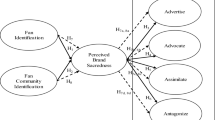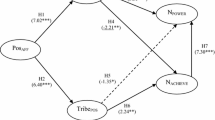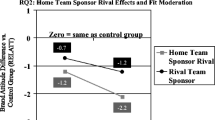Abstract
Like in many other areas, football clubs are confronted with the challenge to expand international activities and to exploit new football markets abroad without upsetting the local fans who have supported the team, often for decades. The purpose of this study is to analyze the impact of fan attitudes toward the internationalization of football clubs on attitudinal and behavioral loyalty. Based on the integration-responsiveness framework and the brand loyalty concept, seven hypotheses were tested through multivariate regression analyses against a sample of 3857 football fans from 10 different countries. The results show a negative impact of internationalization activities that create tension among local fans on attitudinal loyalty, such as business activities, players and coaches, and owners. However, the results show no significant impact of such activities on behavioral loyalty. In contrast, the internationalization of fans and sponsors does not create tension and thus has a positive impact on attitudinal and behavioral loyalty. The relationships between internationalization activities and fan loyalty are partially moderated by the fans’ country of residence. By linking internationalization strategies to the brand loyalty concept, this research contributes to the discussion about standardization and adaptation advantages, and to the discussion on antecedents of brand loyalty. This study helps club managers to plan their internationalization activities effectively. The approach to segment customers into satellite and local fans helps managers to devise segment-specific internationalization activities.

Similar content being viewed by others
References
Babin, B.J., and W.G. Zikmund. 2016. Exploring marketing research. 11th ed. Boston: Cengage.
Bartlett, C.A., and S. Ghoshal. 1998. Managing across borders: The transnational solution. Boston: Harvard Business School Press.
Bauer, H.H., N.E. Sauer, and S. Exler. 2005. The loyalty of German soccer fans: Does a team’s brand image matter? International Journal of Sports Marketing & Sponsorship 7: 14–22.
Bauer, H.H., N.E. Stokburger-Sauer, and S. Exler. 2008. Brand image and fan loyalty in professional team sport: A refined model and empirical assessment. Journal of Sport Management 22: 205–226.
Bennett, R., and S. Rundle-Thiele. 2002. A comparison of attitudinal loyalty measurement approaches. Journal of Brand Management 9(3): 193–209.
Berning, S.C., and D. Maderer. 2017. Chinese investment in the European football industry. In Transcontinental strategies for industrial development and economic growth, ed. B. Christiansen and G. Koc, 223–244. Hershey: IGI Global.
Bian, Q., and S. Forsythe. 2012. Purchase intention for luxury brands: A cross cultural comparison. Journal of Business Research 65: 1443–1451.
Bridgewater, S. 2010. Football brands. Basingstoke: Palgrave Macmillan.
Brown, A. 2007. ‘Not for sale’? The destruction and reformation of football communities in the Glazer takeover of Manchester United. Soccer & Society 8(4): 614–635.
Bruce, I. 1995. Do not-for-profits value their customers and their needs? International Marketing Review 12(4): 77–84.
Buzzell, R.D. 1968. Can you standardize multinational marketing? Harvard Business Review 46(6): 102–113.
Cattaneo, E., and C. Guerini. 2012. Assessing the revival potential of brands from the past: How relevant is nostalgia in retro branding strategies? Journal of Brand Management 19(8): 680–687.
Cavusgil, S.T., and U. Yavas. 1984. Transfer of management knowhow to developing countries: An empirical investigation. Journal of Business Research 12(1): 35–50.
Cavusgil, S.T., and S. Zou. 1994. Marketing strategy-performance relationship: An investigation of the empirical link in export market ventures. Journal of Marketing 58(1): 1–21.
Chaudhuri, A., and M.B. Holbrook. 2001. The chain of effects from brand trust and brand affect to brand performance: The role of brand loyalty. Journal of Marketing 65(2): 81–93.
Comrey, A.L., and H.B. Lee. 1992. A first course in factor analysis. Hillsdale: Erlbaum.
Conn, D. 1997. The football business: Fair game in the ‘90 s?. Edinburgh: Mainstream.
Cronin, M. 1997. ‘Which nation, which flag? Boxing and national identities in Ireland. International Committee for Sociology Sport 32: 131–146.
Deloitte. (2014). A premium blend—Annual review of football finance. http://www2.deloitte.com/content/dam/Deloitte/uk/Documents/sports-business-group/deloitte-uk-annual-review-football-finance.pdf. Accessed 16 Sept 2018.
Desbordes, M. 2012. Marketing & football: An international perspective. 2nd ed. Oxford: Butterworth-Heinemann.
Dick, A.S., and K. Basu. 1994. Customer loyalty: Toward an integrated conceptual framework. Journal of Academy of Marketing Science 22(2): 99–113.
Dolles, H., and S. Söderman. (2005). Globalization of sports: The case of professional football and its international management challenges. German Institute for Japanese Studies, working paper no. 05/1, http://www.dijtokyo.org/publications/WP05_1GlobalizationOfSportsProfessionalFootballDollesSoederman.pdf. Accessed 16 Sept 2018.
Dolnicar, S., and K. Lazarevski. 2009. Marketing in non-profit organizations: An international perspective. International Marketing Review 26(3): 275–291.
Duke, V. 2002. Local tradition versus globalisation: Resistance to the McDonaldisation and Disneyisation of professional football in England. Football Studies 5(1): 5–23.
Falcous, M., and J. Maguire. 2005. Globetrotters and local heroes? Labour migration, basketball and local identities. Sociology of Sport Journal 22: 137–157.
Funk, D.C., and J.D. James. 2006. Consumer loyalty: The meaning of attachment in the development of allegiance. Journal of Sport Management 20: 189–217.
George, D., and P. Mallery. 2003. SPSS for windows step by step: A simple guide and reference. 11.0 update. 4th ed. Boston: Allyn & Bacon.
Giulianotti, R. 1999. Football: The sociology of a global game. Cambridge: Polity Press.
Giulianotti, R., and R. Robertson. 2004. The globalization of football: A study in the glocalization of the ‘serious life’. British Journal of Sociology 55(4): 545–568.
Gladden, J.M., and D.C. Funk. 2001. Understanding brand loyalty in professional sport: Examining the link between brand associations and brand loyalty. International Journal of Sports Marketing & Sponsorship 3: 67–94.
Gladden, J.M., and D.C. Funk. 2002. Developing an understanding of brand associations in team sport: Empirical evidence from consumers of professional sport. Journal of Sport Management 16: 54–81.
Gladden, J.M., and G.R. Milne. 1999. Examining the importance of brand equity in professional sports. Sport Marketing Quarterly 8: 21–30.
Hamil, S., and S. Chadwick. 2010. Managing football. An international perspective. London: Routledge.
Holt, D.B., J.A. Quelch, and E.L. Taylor. 2004. How global brands compete. Harvard Business Review 82(9): 68–75.
Hu, A.W., and O. Bedford. 2012. Development and validation of the sports fan ethnocentrism scale. Social Behavior and Personality: An International Journal 40(2): 215–225.
Hult, G.T., D.J. Ketchen Jr., D.A. Griffith, C.A. Finnegan, T. Gonzalez-Padron, N. Harmancioglu, and S.T. Cavusgil. 2008. Data equivalence in cross-cultural international business research: Assessment and guidelines. Journal of International Business Studies 39: 1027–1044.
Iglesias, O., J.J. Singh, and J.M. Batista-Foguet. 2012. The role of brand experience and affective commitment in determining brand loyalty. Journal of Brand Management 18(8): 570–582.
Jain, S.C. 1989. Standardization of international marketing strategy: Some research hypotheses. Journal of Marketing 53(1): 70–79.
Katsikeas, C.S., S. Saeed Samiee, and M. Theodosiou. 2006. Strategy fit and performance consequences of international marketing standardization. Strategic Management Journal 27(9): 867–890.
Kaynak, E., G.G. Salman, and E. Tatoglu. 2008. An integrative framework linking brand associations and brand loyalty in professional sports. Journal of Brand Management 15 (5): 336–357.
Kerr, A.K., and J.M. Gladden. 2008. Extending the understanding of professional team brand equity to the global marketplace. International Journal of Management and Marketing 3(1&2): 58–77.
Kline, R.B. 2011. Principles and practice of structural equation modeling. New York: The Guilford Press.
Kloke, J. (2016). Can Bayern Munich become America’s favourite football team?. The Guardian. https://www.theguardian.com/football/2016/may/18/bayern-munich-americas-favourite-football-team. Accessed 18 May 2016.
Krosnick, J.A., D.S. Boninger, Y.C. Chuang, M.K. Berent, and C.G. Carnot. 1993. Attitude strength: One construct or many related constructs? Journal of Personality and Social Psychology 65(6): 1132–1151.
Laurens, J. (2017). PSG convinced Neymar signing opens the way to Champions League glory. The Guardian. https://www.theguardian.com/football/2017/aug/03/neymar-paris-saint-germain-champions-league-ambitions. Accessed 3 August 2017.
Lehnebach, N. 2014. Bundesliga-Internationalisierung. Mehr Takaharas. Sponsors 10: 18.
Lynch, M. (2015). Could sponsor pressure for Asian tour push Manchester United towards Australia? Sydney Morning Herald. http://www.smh.com.au/sport/soccer/could-sponsor-pressure-for-asian-tour-push-manchester-united-towards-australia-20150731-gip5jg.html. Accessed 2 August 2015.
Maderer, D., D. Holtbrügge, and R. Woodland. 2016. The impact of brand associations on brand loyalty in the football industry. Sport, Business and Management: An International Journal 6(5): 499–519.
Madichie, N. 2009. Management implications of foreign players in the English Premiership League football. Management Decision 47(1): 24–50.
Mahony, D.F., R. Madrigal, and D. Howard. 2000. Using the psychological commitment to team (PCT) scale to segment sport consumers based on loyalty. Sport Marketing Quarterly 9(1): 15–25.
Meng-Lewis, Y., D. Thwaites, and K.G. Pillai. 2013. Consumers’ responses to sponsorship by foreign companies. European Journal of Marketing 47(11&12): 1910–1930.
Muniz, A.M., and T.C. O’Guinn. 2001. Brand community. Journal of Consumer Research 27(4): 412–432.
Nash, R. 2000. Globalised football fandom: Scandinavian Liverpool FC supporters. Football Studies 3(2): 5–23.
Nauright, J., and J. Ramfjord. 2010. Who owns England’s game? American professional sporting influences and foreign ownership in the Premier League. Soccer & Society 11(4): 428–441.
Nunnally, J.C. 1967. Psychometric theory. New York: McGraw-Hill.
Parganas, P., C. Anagnostopoulos, and S. Chadwick. 2015. ‘You’ll never tweet alone’: Managing sports brands through social media. Journal of Brand Management 22(7): 551–568.
Podsakoff, P.M., S.B. MacKenzie, J. Lee, and N.P. Podsakoff. 2003. Common method biases in behavioral research: A critical review of the literature and recommended remedies. Journal of Applied Psychology 88(5): 879–903.
Prahalad, C.K., and Y.L. Doz. 1987. The multinational mission: Balancing global integration with local responsiveness. New York: The Free Press.
Prior, E. (2013). Do Man Utd really have 659 m supporters? BBC News. http://www.bbc.com/news/magazine-21478857. Accessed 18 Feb 2013.
Puck, J.F., and T. Wirth. 2009. Die Internationalisierung des FC Bayern München. In Management internationaler Dienstleistungen mit 3 K. Konfiguration – Koordination – Kundenintegration, ed. D. Holtbrügge, H. Holzmüller, and F.V. Wangenheim, 111–128. Wiesbaden: Gabler.
Richelieu, A., and F. Pons. 2006. Toronto Maple Leafs vs Football Club Barcelona: How two legendary sports teams built their brand equity. International Journal of Sports Marketing & Sponsorship 7(3): 231–250.
Ross, S.D., and P. Walsh. 2011. Developing global brand equity in the spectator sport industry. International Journal of Sport Management 12: 411–428.
Schmid, S., and T. Kotulla. 2011. 50 Years of research on international standardization and adaptation—From a systematic literature analysis to a theoretical framework. International Business Review 20(5): 491–507.
Schmitt, N. 1996. Uses and abuses of coefficient Alpha. Psychological Assessment 8(4): 350–353.
Shoham, A. 1996. Marketing-mix standardization: Determinants of export performance. Journal of Global Marketing 10(2): 53–73.
Sloan, L., and A. Quan-Haase (eds.). 2017. The Sage handbook of social media research. Los Angeles: Sage.
Solberg, C.A. 2000. Standardization or adaptation of the international marketing mix: The role of the local subsidiary/representative. Journal of International Marketing 8(1): 78–98.
Szymanksi, D., S.G. Bharadwaj, and P.R. Varadarajan. 1993. Standardization versus adaptation of international marketing strategy: An empirical investigation. Journal of Marketing 57(3): 1–17.
Szymanski, S. 2016. Professional Asian football leagues and the global market. Asian Economic Policy Review 11: 16–38.
Tajfel, H. 1981. Human groups and social categories. Cambridge: Cambridge University Press.
Tan, Q., and C.M.P. Sousa. 2013. International marketing standardization. A meta-analytic estimation of its antecedents and consequences. Management International Review 53(5): 711–739.
Theodosiou, M., and L.C. Leonidou. 2003. Standardization versus adaptation of international marketing strategy: An integrative assessment of the empirical research. International Business Review 12: 141–171.
van Schaik, T. (2012). The psychology of social sports fans: What makes them so crazy? Sportsnetworker.com. http://www.sportsnetworker.com/2012/02/15/the-psychology-of-sports-fans-what-makes-them-so-crazy/. Accessed 15 Feb 2012.
Veth, K.M. 2014. The Berlusconization of Post-Soviet Football in Russia and the Ukraine: Money scores goals, goals win titles, and titles win popularity. Journal of Sport History 41(1): 55–72.
Vrontis, D., A. Thrassou, and I. Lamprianou. 2009. International marketing adaptation versus standardisation of multinational companies. International Marketing Review 26(4&5): 477–500.
Walsh, A.J., and R. Giulianotti. 2001. This sporting mammon: A normative critique of the commodification of sport. Journal of the Philosophy of Sport 28(1): 53–77.
Wann, D.L., and S. Pierce. 2003. Measuring sport team identification and commitment: An empirical comparison of the Sport Spectator Identification Scale and the Psychological Commitment to Team Scale. North American Journal of Psychology 5(3): 365–372.
Yoo, B., and N. Donthu. 2002. Testing cross-cultural invariance of the brand equity creation process. Journal of Product and Brand Management 11(6): 380–398.
Zhang, S., J. Doorn, and P.S.H. Leeflang. 2014. Does the importance of value, brand and relationship equity for customer loyalty differ between Eastern and Western cultures? International Business Review 23(1): 284–292.
Author information
Authors and Affiliations
Corresponding author
Rights and permissions
About this article
Cite this article
Maderer, D., Holtbrügge, D. International activities of football clubs, fan attitudes, and brand loyalty. J Brand Manag 26, 410–425 (2019). https://doi.org/10.1057/s41262-018-0136-y
Revised:
Published:
Issue Date:
DOI: https://doi.org/10.1057/s41262-018-0136-y




